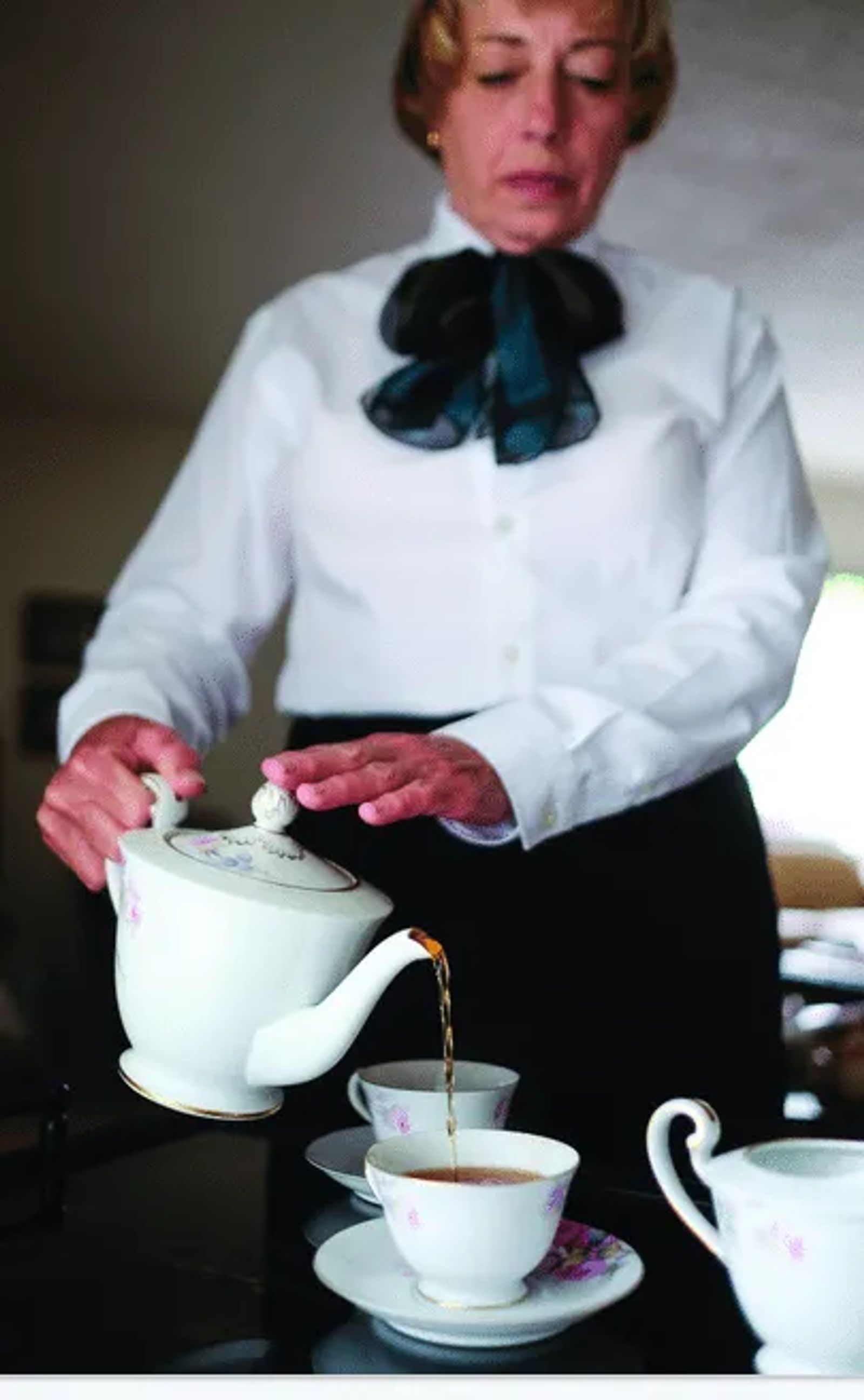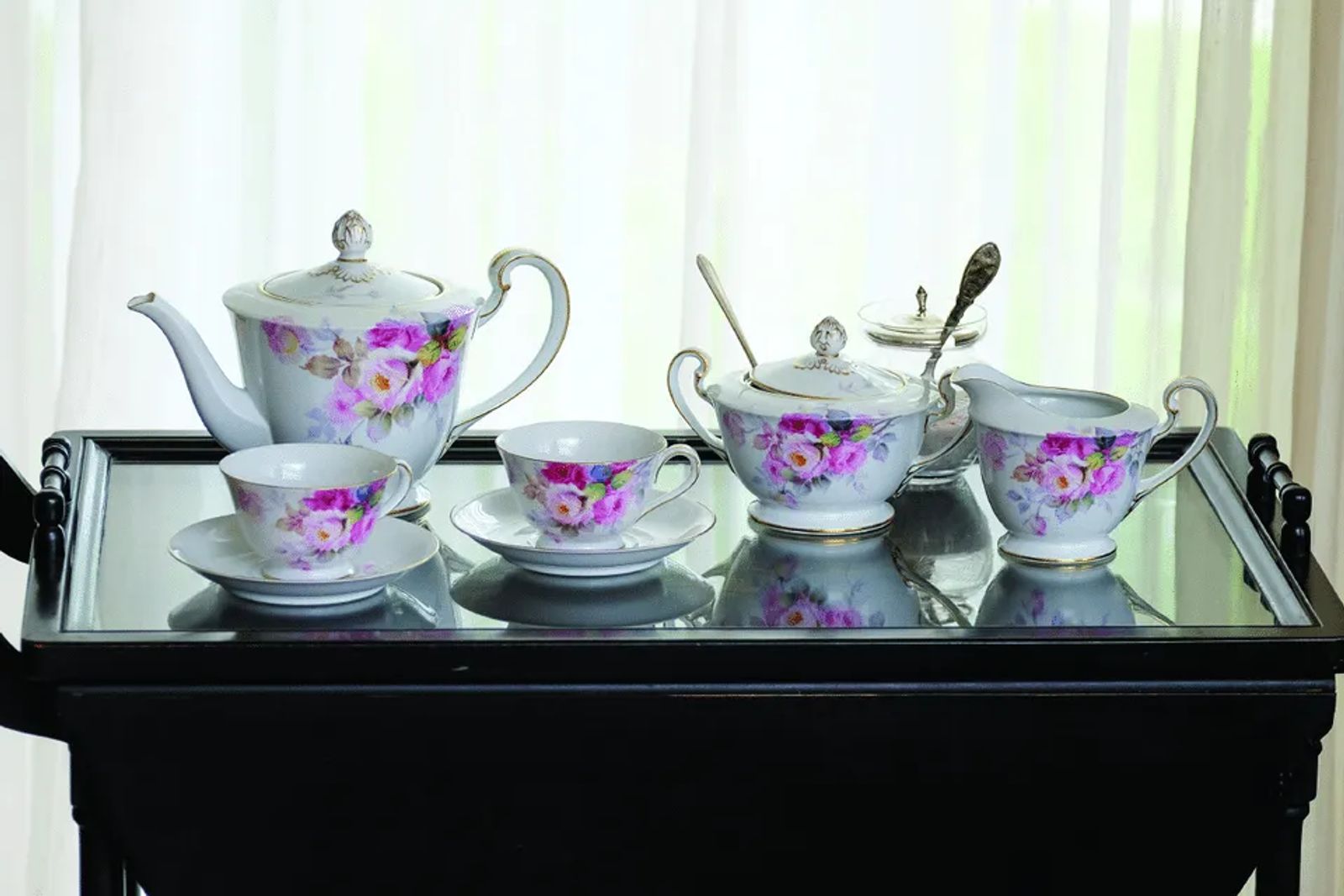
The Healthy Habit of Tea
A Healthy Habit
Editor’s Note: Yellowstone Valley Woman first brought you the story of Treva Mayo and her background as a professional butler and etiquette consultant in our August/September issue. This is the second part of Treva’s story where she shares a little bit about one of her favorite topics —tea.
There aren’t many flavors that Treva Mayo hasn’t sipped. We are talking about one of her favorite “brews”, which just so happens to be the second most widely consumed drink in the world – tea. She’s joined by 158 million Americans who have a cup on any given day. Do you know how to properly drink a cup? Or, do you know any of the history behind this popular beverage? Never fear, this professionally-trained butler and etiquette consultant, who has shared her expertise in elite households and before royal audiences, gives us some fascinating tea facts and a bit of etiquette to go with it.
THE HISTORY OF TEA
“Tea has been in existence for thousands of years,” says Treva, looking over the variety of tea leaves she’s displayed on her dining room table.
Legend has it that Chinese Emperor Shen-Nong discovered tea accidently in 2737 B.C. He was boiling water when leaves from a tree drifted into the pot. He drank the beverage and apparently liked it. Over time, this flavorful and aromatic brew grew, spreading throughout China well into the era of Northern China’s Tang Dynasty (618-907 A.D.). “The Chinese served their tea in a blue cup as it appeared greener,” notes Treva. “Everything about tea was beautiful. It was part of an art form.”
There was a time, however, when Mongolian warrior and ruler Genghis Khan practically “wiped out tea and Chinese history,” reports Treva. During the Mongol Empire in the early 1200s, Khan’s conquests wreaked havoc on Chinese rulers and their royal courts. “When Marco Polo came through China later that century only the common people were drinking tea.”
It wasn’t until the 17th century that tea arrived in England thanks to King Charles II. “All the coffee houses in England were for men,” says Treva, “so King Charles II introduced tea to the coffee houses. Tea eventually became affordable enough to sell by the pound in these establishments, so women started drinking it.”
The king’s wife, a Portuguese princess, brought tea into royal circles. Soon the aristocracy established ‘afternoon tea,’ which, adds Treva, “grew into an elaborate affair.” Sugar coming from the West Indies only made tea consumption that much more popular in England.
In time, tea came to be taxed in England. “It became expensive and was stored in well-made wooden chests,” continues Treva. “The lady of the house always carried a key to the tea chest with her. Servants had to ask her for the key and she would watch them take out the tea. I’ve seen these tea chests at the Smithsonian.”
The chests no doubt came to American shores when the first tea was brought to the colonists in the Dutch settlement of New Amsterdam (later re-named New York by the English) in 1650. Over a century and a half later, New York tea importer Thomas Sullivan sparked a new invention. “He made silk bags containing tea,” explains Treva, “and sent them out for people to try. The people loved it and started demanding tea bags!”
Even with its use dating back thousands of years, the U.S. market for tea has grown more than four times in the past 20 years. As a commodity, a social connection, a ceremonial component, plus, a beverage offering health benefits, this stimulating and all-natural liquid refreshment has become second only to water as the world’s most widely consumed drink.

TYPES OF TEA
“All tea comes from two plants,” states Treva. “The Camellia sinensis, (a warm-weather evergreen shrub native to Asia), which is the original tea plant from China, and the Camellia assam (which may be a variety of Camellia sinensis) from India.”
Black, green, oolong and white teas derive from the Camellia sinensis plant. Differences among these four types of tea result from how they are processed and the level of oxidization (tea leaves are broken and exposed to air). Black tea is fully oxidized and oolong teas are partially oxidized. After the tea leaves wither and are rolled, they undergo natural chemical reactions. These reactions develop the teas’ distinguishing characteristics of taste and color. Green and white teas are not oxidized after leaf harvesting.
“Tea is an amazing little substance,” giggles Treva setting the tin down, “and I love it! When you’ve had really good tea, it’s so exciting! You’re able to taste the smoothness, the astringency, and the flavors, whether fruity, floral or nutty.”
Although tea originated from China, the Assam region of India recognizes a native plant that produces tea. From Assam, India, the second largest producer and exporter in the world next to China, comes Darjeeling tea. Breakfast blends are usually made with Assam teas.
Not to be confused with teas made from the Camellia sinensis or the Assam plants, are herbal teas. Herbal tea refers to herbal infusions of fruits, flowers and herbs like steeps of chamomile, rosehip or rooibos (made from a South African red bush). Herbal tea is made without the tea plant.
Today, most tea is grown in mountainous areas 3,000 – 7,000 feet above sea level in mineral-rich and acidic soil. Other top tea-producing countries include Argentina, Indonesia, Japan, Kenya, Malawi, Sri Lanka, Tanzania and Taiwan.
THE TASTES OF TEA
Each tea brings a unique flavor, a different aroma to the senses. Treva compares tasting fine teas to tasting fine wines. “I realized at butler school during our intense wine and cigar training that they are all the same. For tea (the leaves), wine (the grapes) and cigars (the tobacco), it’s about the soil, the region and elevation where they’re grown, even the hours of sunlight they receive. It makes the product unique and gives it its quality.”
Regarding quality, Treva insists, “You want to know where your tea comes from. What you’re drinking is the elixir of the leaf. Whatever has been on that leaf, you are drinking.” So, research where your tea leaves stem from and how the leaves are treated, as far as, pesticide and other chemical use. “It’s the tea sommelier who learns to taste the difference of a quality tea.”
Treva suggests Tea City here in Billings for acquiring good teas. She nods that Earl Grey produces wonderful teas, and, the Harney family whom she knows, owners of Harney & Sons, an American Tea company based in New York, rates high on her list. Palm Court Blend, a medium-bodied tea from Harney & Sons, is Treva’s favorite.
Black tea boasts a stronger and more full-bodied flavor than green or oolong teas. Treva’s other “new favorite,” is Pu-erh, a rich, black tea aged in caves up to 15 years. Pu-erh tea embodies a smooth and earthy flavor.
Green tea is the most popular type of tea and contains the most polyphenols (antioxidants). It’s high in vitamin C, according to Treva. Some loose green teas are scented with flowers or mixed with fruits to create scented or flavored teas.
Oolong tea, also known as Wu long tea, is full-bodied with a flavorful fragrance and sweet floral aroma. It tastes similar to green tea. You’ll find oolong tea served in Chinese restaurants.
White tea is the purest and least processed of all teas, however, it may have less nutrition than other teas. It’s the lowest in caffeine and exudes a subtle, delicate flavor and aroma. This loose leaf tea brews a light color and flavor.
THE HEALTH BENEFITS OF TEA
Tea contains smaller amounts of caffeine than coffee. It is packed with nutrients, vitamins and immune boosters. “Green tea is amazing for your health,” advises Treva. “Scientists used to say, ‘we think,’ now, they say, ‘we know’ it helps prevent cancers.”
Backing this up is a Harvard Men’s Health Watch story (September 2014). Tea, especially green tea, “contains substances linked to lower risk for heart disease, cancer and diabetes. The main health-promoting substances in tea are polyphenols, in particular catechins and epicatechins,” these are molecules offering anti-inflammatory and antioxidant properties.
Even Dr. Oz reads the tea leaves and finds that certain teas like passionflower extends anti-anxiety benefits. Oolong tea boosts metabolism, therefore, burning fat to speed weight loss. Remember to pass on the sugar and/or honey as these ingredients negate the benefits. He states on his website that white tea contains an antioxidant that “prevents new fat cells from forming and fights signs of aging, like wrinkles.” With all of these benefits, what’s not to like about tea?
“Tea habit is a healthy habit,” says Treva.
TEA TRUTHS
* Tea is gluten-free, contains virtually no calories and is packed with nutrients, vitamins and antioxidants
* Green tea used as a mouthwash may prevent gingivitis
* It takes 1,000 tea leaves to make one pound
* Tea plants are propagated from seed & cuttings, taking 4 to 12 years for a plant to bear seed
* A tea plant can grow into a tree up to 52 feet tall if left undisturbed
* Cultivated plants are usually grown waist-high
* In the United States, about 85% of tea consumed is iced tea
* A good loose tea can be brewed up to 3 or 4 times before discarding
TREVA’S TEA ETIQUETTE
The Dos and Don’ts of drinking tea
* Never lift your pinky finger when sipping tea
* Never make a sound when stirring tea with a spoon, instead make little swirling motions
* After stirring tea, place the spoon on the back of the saucer
* Never squeeze the tea bag and use a separate saucer to place the used tea bag
* When using lemon slices, place slice into the cup and never squeeze or remove the slice
* ‘Afternoon tea’ is the dainty affair with crumpets/biscuits/cookies and not to be confused
with ‘high tea’ which is at 5 p.m. for the working class. “This is strong black tea served family-
style with meat pies, breads and cheese.”
BREWING THE PERFECT CUP
The proper ‘tea times’
* White tea – 165 - 180 degrees, steep 4 to 6 minutes
* Green tea – 160 degrees, steep 2 to 4 minutes
* Black and herbal teas - around 200 degrees, 4 to 6 minutes
* Oolong tea – 190 degrees; steep 5 to 8 minutes










